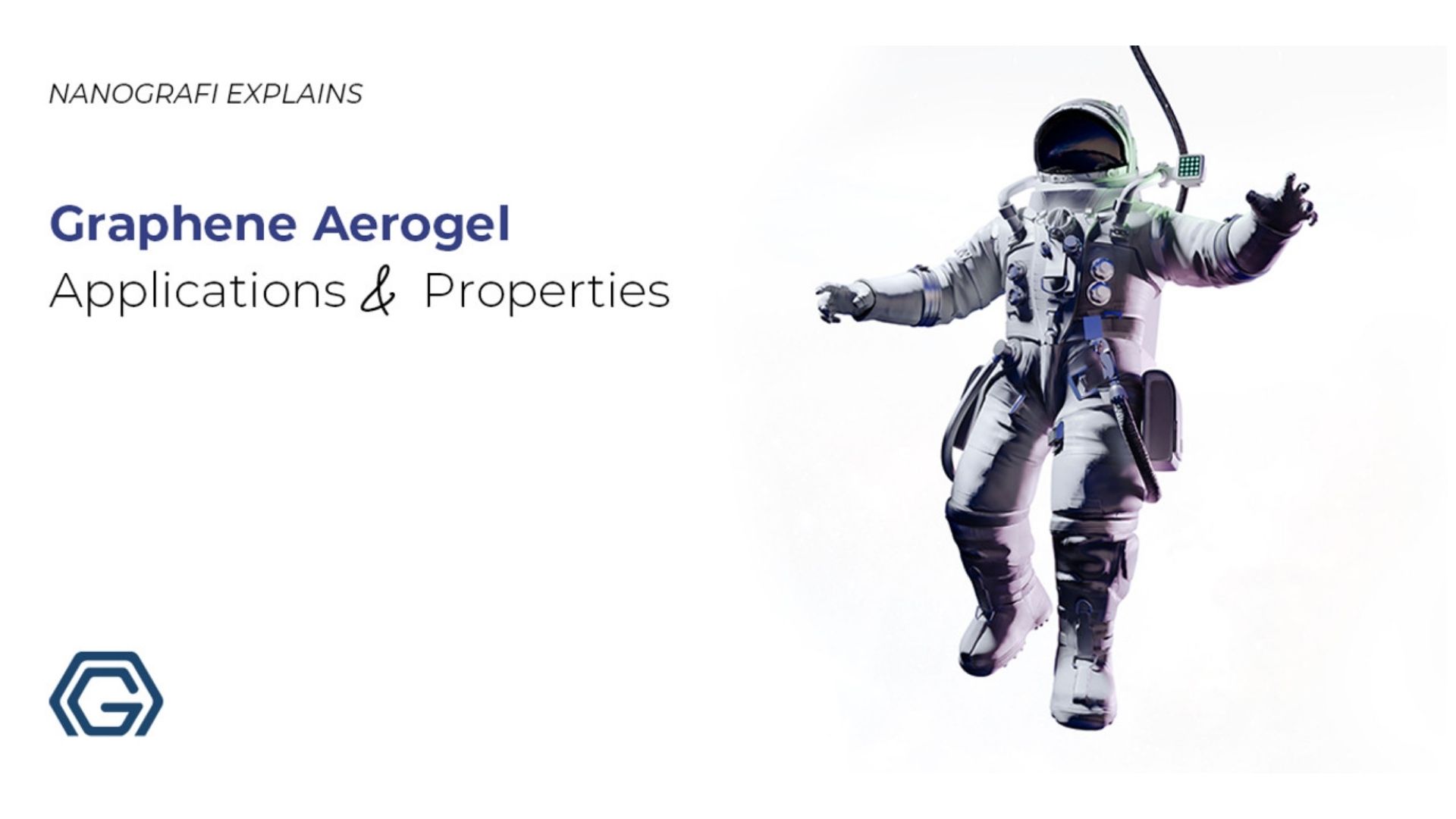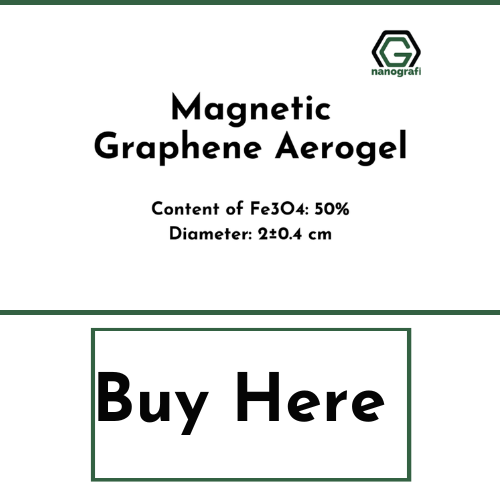Graphene Aerogels
Graphene aerogels (GAs) are materials that combine the intriguing properties of graphene with the tunable 3-D nature of aerogel structure.
The high surface area, porous structure, thermal and electrical conductivity, mechanical strength, and chemical stability of GAs are widely utilized in energy storage applications and environmental protection processes.Graphene aerogels are novel structures that have recently attracted attention due to their excellent intrinsic properties.
Introduction
Graphene is an interesting 2-D material with a high specific surface area (2630 m2g−1), high young modulus (~1 TPa), thermal conductivity (~ 5000 Wm−1K−1) and optical transmittance (~ 97,7%), chemical stability and good electrical conductivity. Since the time of its discovery, 2004, different studies have been conducted to incorporate graphene into other environments such as polymeric media. However, due to the poor dispersion of graphene, this has remained a challenge until the development of methods to convert the 2-D structure of graphene into 3-D structures such as aerogels, hydrogels, and macroporous films. Amongst these structures, aerogels are found to be the most promising option.
Aerogels are the lightest solid materials known with their low density (0.003–0.15 kg m-3), high porosity and large surface areas (500–1000 m2g−1). Furthermore, aerogels show desirable mechanical and physicochemical properties. GAs can withstand up to14,000 of their own weight. The pore size and surface area of aerogels can be adjusted through different methods. Graphene aerogels benefit the 3-D nature, the highly porous and tunable structure of aerogels, and the excellent properties of graphene. The GAs structure can be lighter than air, show high specific capacitance and high cyclic stability. The structure and consequently the properties of GAs are manipulated through the changes in fabrication parameters.
Fabrication Methods of Graphene Aerogels (GAs)
Aerogel production consists of three stages; gel formation, solvent exchange, and drying process. The gel formation step determines the shape of aerogels while solvent exchange and drying steps are important for the preservation of the aerogel structure.
Graphene oxide (GO) is usually preferred as the precursor material for GAs fabrication due to its high dispersion in aqueous media and its functionality. GO can either be reduced to graphene sheets for graphene aerogel production or used for the preparation of graphene-based GAs as well. Oxygen in the GO structure is able to bond covalently with various different compounds and thus yield new materials with properties that can be tailored to specific applications. For example, the immobilization of biopolymers on GO sheets enhances the biocompatibility of the GAs without affecting their performance. GO is usually produced by chemical oxidation of graphite powder.
The most frequently used methods used in GAs formation are hydrothermal reduction, chemical reduction, cross-linking methods, sol-gel method, and template-directed reduction.
Hydrothermal Reduction Method
The hydrothermal reduction method is the most common and used approach to produce a graphene hydrogel. In this method, GO is reduced to graphene nanosheets (GNS) is followed by the self-assembly of GNS into 3-D aerogel structure and the drying step. Cross-linking agents such as polymers and metal ions are used in the hydrothermal reduction method. Also, high temperatures and pressures are required to control the gelation rate and gel integrity.
Chemical Reduction Method
The chemical reduction method uses mild reduction agents like hydrazine, Vitamin C, and sodium ascorbate. As opposed to hydrothermal reduction, the chemical reduction method does not require high temperatures and cross-linkers hence, it is considered to be more desirable. The process of chemical reduction of graphene-based materials often leads to a small surface area since the graphene layers restack through a π–π interaction during the process.
Cross-Linking Methods
Cross-linking methods either utilize hydrogen bonds or multi-valent metal ions. The electrostatic repulsion in the GO solution weakens as the pH of the solution decreases and the hydrogen bonding increases due to the protonation of carboxyls. This leads to the strengthening of the hydrogen bonding and, the formation of a stable GO gelation. To promote the GO gelation cross-linkers such as hydroxyl, oxygen-containing, or nitrogen functional groups are used. Alternatively, the self-assembly and gelation of GO sheets are promoted by divalent and trivalent ions like Ca2+, Mg2+, Pb2+, or Cr3+. These metal ions interact with a single GO by a bonding force. The concentration of GO affects pore density and size.
Sol-Gel Method
In the sol-gel method, polymerization creates covalent bonds between GO sheets hence the bonds between GO sheets are stronger than the cross-linking method. The GAs obtained by this method can acquire large surface area (361–763 m2g−1 ), low density (0.11–0.19 gcm−3 ), high pore volume, narrow pore size distribution (10–50nm) and high conductivity (528 S m−1 ).
Template-Directed Reduction
The template-directed reduction method offers great tuning ability. Since it prevents random interconnection it is possible to manipulate uniform macropores and tailorable microstructure. Also, it is an appropriate method to obtain porous GAs structures.
Novel approaches to GAs production are 3D printing and freeze gelation. In the freeze gelation method, pristine graphene aerogels are prepared by mixing with an organic solvent above its boiling point, usually for temperatures between 50 and 120 °C, and cooled to form a solid-state material at RT. The solution can be treated with processes such as molding, extrusion, or printing. 3D printing is utilized for the preparation of GO aerogels with complex structures. An aqueous solution of GO is formed in a polymer solution to promote gelation after deposition. Gelation is achieved through water removal either by freeze-drying or supercritical drying. The PG aerogels with graphene concentration of 20 and 40mg cm−3 had Young’s modulus values equal to 7.7 ± 1.0 and 82.5 ± 4.0 kPa, respectively, and yield strength of 0.4 ± 0.01 and 2.1 ± 0.2 kPa.
To get more information about graphene aerogels and their applications,
you can read our blog post here.
The drying step in GAs fabrication can be carried out in supercritical conditions or at low pressure and at a temperature below the melting point (freeze-drying). Freeze-drying is the most commonly used process due to its simple operation and easy conditions. However, it requires a long time. The most reliable and environmentally friendly drying method is found to be supercritical drying.
Applications of Graphene Aerogels
Graphene aerogels produced by the above-mentioned methods have excellent tunable properties such as high electrical conductivity, high mechanical strength, thermal stability, and high adsorption capacity for dyes, oils, organic solvents, and inorganic ions. These intrinsic properties of graphene aerogels are utilized in various different application areas. The main application areas of graphene aerogels can be listed as energy storage, environmental protection, and, photocatalysis.
Energy Storage
The increasing energy demand of the modern world has pushed the science community to come up with creative ideas and solutions. The depletion of energy sources and environmental concerns as well as the technological developments in backup storage devices, portable electronic devices, cardiac pacemakers, and hybrid electric vehicleshave especially prioritized the need for energy storage systems. Supercapacitors which are electrochemical energy storage devices have gained a lot of attention with their high-power density, high specific energy, and long life (>100,000 cycles). Furthermore, flexible solid-state supercapacitors are important for wearable electronic devices. Supercapacitors are formed from two electrodes, an electrolyte, and a separator.Graphene has been suggested to be utilized in supercapacitors because of its high surface area high electrical conductivity and chemical stability, as well as excellent mechanical, thermal, and optical properties. However, the 2-D nature of graphene undergoes a loss of surface area during the reduction process. The 3-D structure of graphene aerogels is considered to be the solution to this problem. The GAs exhibit a specific capacitance of 128 F g−1 and could be used as electrodes for electrochemical power sources. Furthermore, the high surface area and the porous structure of GAs allow more charge carriers (electrolyte ions or radicals) to be stored in a given volume, which increases the capacitance of the supercapacitors. It is common practice to include functionalized groups such as metal oxides, oxygen, nitrogen, sulfur, boron, KOH, and CO2 in order to further increase the capacitance of graphene aerogels. In addition to supercapacitors, graphene aerogels are also utilized in the electrodes of Lithium-ion batteries (LIBs) for enhancing the performance of these well-known structures.
Environmental Protection
Environmental protection is another hot topic in the science community. Especially the air and water pollution are serious problems awaiting effective solutions. Graphene aerogels are suggested as a promising option for environmental protection processes such as wastewater treatment and air pollution control. The absorption capacity, chemical stability, porous structure, and high surface area of GAs are attractive properties for these applications. Graphene aerogels have a high absorption ability for several oils and organic solvents and can be regenerated by the drying process above its melting point. Hence, it can be used for clearing spilled oils and other pollutants in water. The regeneration capability is attributed to the strong network of the surface-modified GA that ensures chemical and mechanical durability.
Additionally, the high surface area and electrical conductivity of graphene aerogels present great potential in photocatalytic applications. The application of three-dimensional (3D) aerogels for immobilizing powder catalysts can greatly enhance the catalyst cycling stability. Materials with high photocatalytic activity such as CdS and TiO2 quantum dots are combined with the GAs structure and used for the degradation of organic pollutants in water. Sulfur and nitrogen-doped graphene aerogels are also utilized in the absorption and catalytic degradation of dyes and organic pollutants. Furthermore, the high photocatalytic activity can be exploited in air purification and the enhanced specific capacity in fuel cells and supercapacitors.
Conclusion
Graphene aerogels combine the attractive properties of graphene such as high surface area, mechanical strength, electrical and thermal conductivity, optical transmittance, and chemical stability with the 3-D structure of aerogels. This 3-D structure enhances the compatibility of graphene with other media such as polymeric solutions and highly ionic environment of electrodes. Graphene aerogels can be lighter than air while withstanding 14 000 times its own weight. Furthermore, the properties of graphene aerogels can be manipulated through the application of different production methods and parameters. The main fabrication methods of GAs are hydrothermal reduction, chemical reduction, cross-linking methods, sol-gel method, and template-directed reduction. Resulting aerogels are widely utilized in energy storage applications and environmental protection processes.
To discover the latest news from nanotechnology, you can visit Blografi.
References
1.Gorgolis, G., & Galiotis, C. (2017). Graphene aerogels: a review. 2D Materials, 4(3), 032001.
2.Korkmaz, S., & Kariper, İ. A. (2020). Graphene and graphene oxide-based aerogels: Synthesis, characteristics, and supercapacitor applications. Journal of Energy Storage, 27, 101038.
3.Long, S., Wang, H., He, K., Zhou, C., Zeng, G., Lu, Y., ... & Luo, X. (2020). 3D graphene aerogel based photocatalysts: synthesized, properties, and applications. Colloids and Surfaces A: Physicochemical and Engineering Aspects, 124666.
4.Wei, X. N., Ou, C. L., Fang, S. S., Zheng, X. C., Zheng, G. P., & Guan, X. X. (2019). One-pot self-assembly of 3D CdS-graphene aerogels with superior adsorption capacity and photocatalytic activity for water purification. Powder technology, 345, 213-222.
5.Jiang, Y., Chowdhury, S., & Balasubramanian, R. (2019). Nitrogen and sulfur codoped graphene aerogels as absorbents and visible light-active photocatalysts for environmental remediation applications. Environmental pollution (Barking, Essex: 1987), 251, 344-353.
Recent Posts
-
Nanocomposites in Food Packaging
The utilization of nanocomposites in food packaging represents a significant advancement in the fiel …19th Apr 2024 -
What is the Difference Between 7075 and 6061 Aluminum Alloy?
When comparing 7075 aluminum alloy to 6061 aluminum alloy, it's essential to understand their disti …5th Apr 2024 -
Iron-Air Batteries: The Ultimate Guide
Iron-air batteries represent a significant breakthrough in energy storage technology, offering a sus …29th Mar 2024







